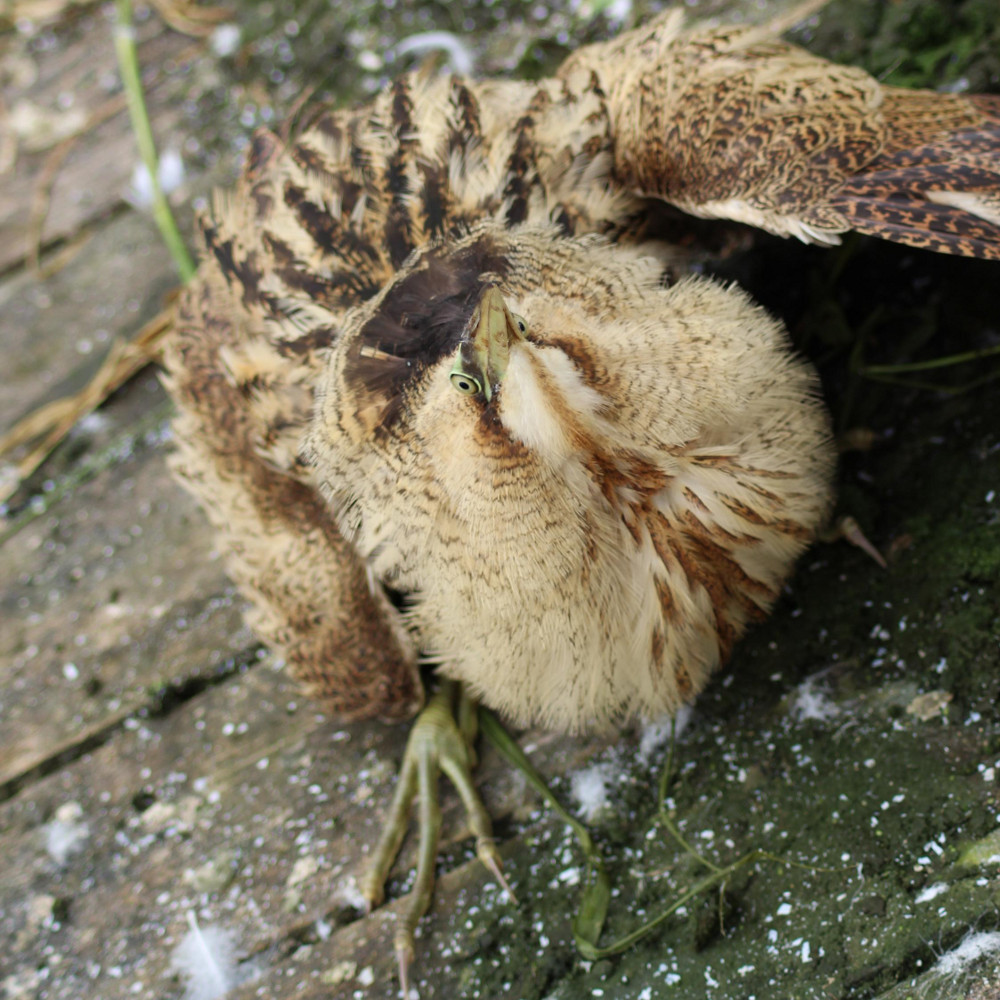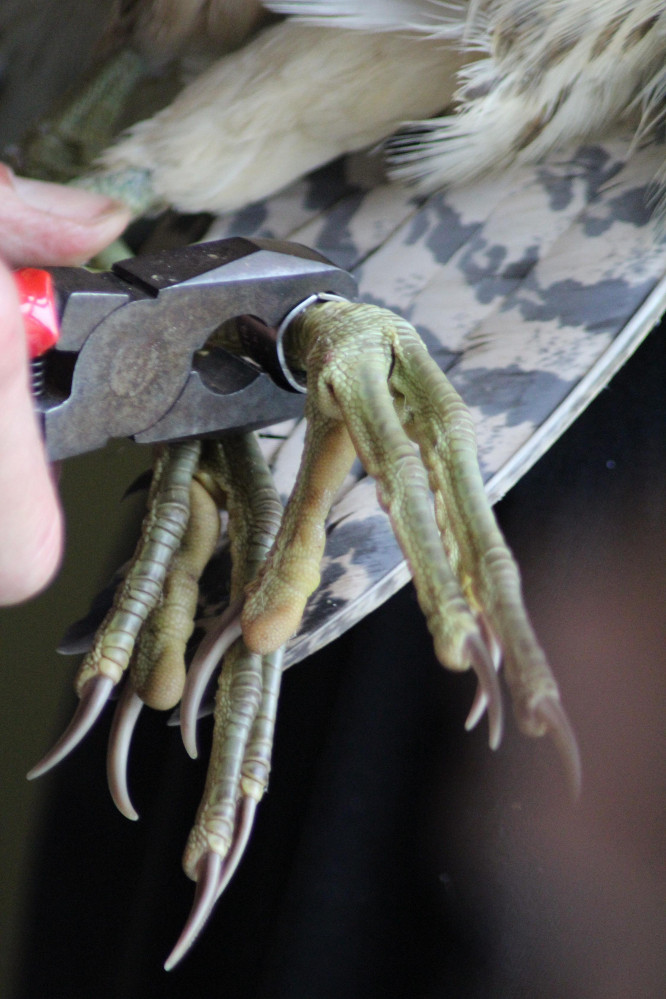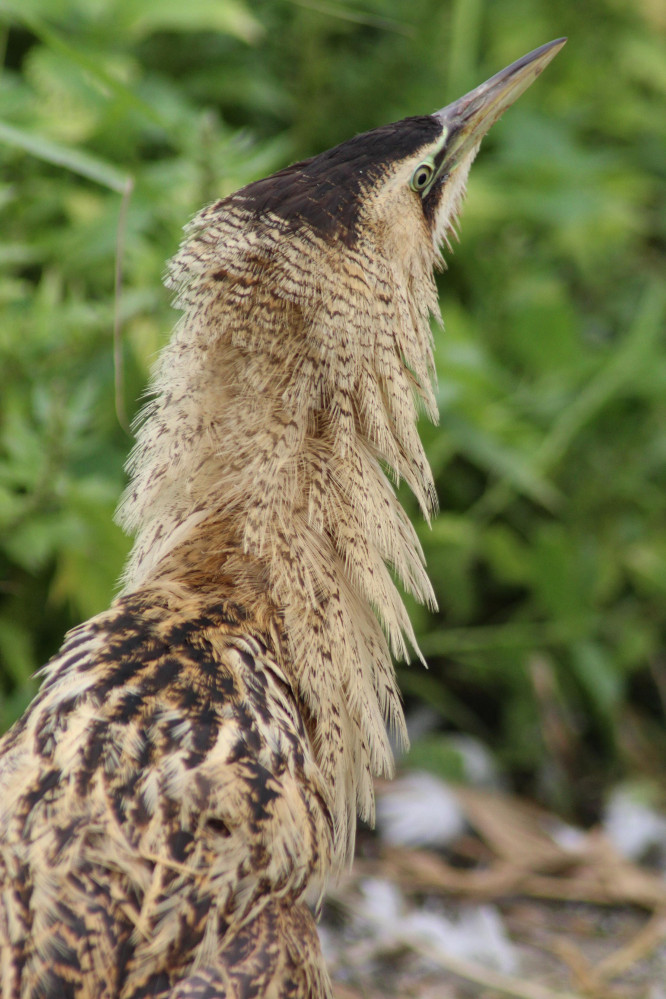Recent activities

A Bittern comes out of rehab
Roger Emmens reports on an unexpected encounter with a magnificent bird
Sunday 18th September was spent netting part of the Works site at Rye Meads, and provided some worthwhile late migrants – plenty of Chiffchaffs and Blackcaps, plus a late Lesser Whitethroat and Willow Warbler, and a total of six warbler species in total, not bad for mid September. Of course, you always wonder what might turn up – surely we are overdue an errant Red-backed Shrike, or a Wryneck perhaps?
So I was unprepared for the new ringing tick which did turn up – and not in a net, either!
Caroline Huxtable from Wildlife Welfare based in Stevenage had received a Bittern, found by a roadside pond near Willian, Letchworth on Thursday 15th September 2016, and taken into care. It had been given the full veterinary check, X rayed, and the vet deemed her bruised but otherwise unharmed, possibly a brush with a car. It had been kept in for a couple of days, and was eating well and putting on weight, so was deemed ready for release.

As the original finding place was a pond with very little cover and was clearly unsuitable, Wildlife Welfare sought advice from the RSPB as to a suitable release site, and they proposed Rye Meads. So when it arrived that Sunday lunchtime, we took the opportunity to ring it – hence my big chance! It was a two-person job – a Bittern is a big bird to handle, and its beak can be a dangerous weapon, particularly to the face and eyes, so Alan Harris held it whilst I ringed it. If you see a ringed Bittern, look for ring number 1500291!
We measured the wing length as 317mm, which indicates a female – the accepted ranges are 335-357 for males, 296-327 for females. The weight was 750g, which is a bit light – healthy weights are quoted as 867-1150 for females (males can be up to almost 2kg), but as she had eaten well in captivity, and seemed lively, the rescuers wanted to release her as soon as it was safe to do so. Live emaciated females can weigh as little as 430g when taken into care!
Ageing the bird proved fairly straightforward. Adult Bitterns moult only some of the wing feathers, or remiges (primaries and secondaries), each year, so an adult bird will have two or three ages of feather in the wing at any time, distinguishable by slightly different colouring, fading due to wear, and signs of abrasion on the older feathers. For a bird hatched this year, all of the remiges will be of the same age, as they were grown at the same time in the nest, and in addition the outer primaries of juveniles are more pointed, and the crown is a uniform dull brown; this was the case for this bird, so we were able to call it a juvenile female.

The final step was the release. We took the bird to the Boardwalk on the back of the Scrape to release it into the reedbed there, pausing on the way to apologise to the occupants of the Draper Hide for disturbing the Scrape and offering them the chance to come along to watch the release by way of compensation. On being set down, she immediately adopted the threat posture – wings partly spread, neck ruff puffed out. We backed away, and after a pause, she turned and slunk off into the reeds with the typical long step, measured gait, looking like the furtive arch-villain in some Hammer Horror movie.
Will we see her again at Rye Meads? We can be hopeful, but Bitterns are very good at hiding in reeds and not showing themselves, and there are plenty of reeds at Rye Meads for them to do that. How long will she stay with us? We might presume that she will need to spend a while building up strength and weight, but after that it is in the nature of juveniles to explore and find new reedbeds and feeding grounds. Perhaps the unexpected repatriation to Rye Meads will have satisfied that wanderlust, perhaps not.
In any case, chances are we will not know what happens to her. From the latest available figures from the BTO, just 20 of the 188 Bitterns ever ringed have subsequently been reported, just over 10%. Let’s hope our bird has a happy outcome, but it would be nice to know what has become of her!
Ageing and sexing characteristics from Birds of the Western Palearctic; photos courtesy of Vicky Buckel. Thanks to Caroline Huxtable and Wildlife Welfare for the rescue and giving us all the opportunity to see this magnificent bird up close.

Last photographed on 3rd October, alive and well. A second, unringed Bittern photographed on 5 November.
[…] the September WeBS count of 429 Gadwalls continues the unusually high counts of this Autumn. The rescue Bittern which was imported onto the site in September was subsequently seen at least three times (and […]
Having probably spent some time at Amwell (where a left leg ringed Bittern was photographed by Ron Baber on 4 Dec 2016), she was back at Rye Meads on 22 Feb 2017, when Jay Ward took some remarkable shots enabling her ring number to be read.
We are aware of some tantalising – but not conclusive – sightings of a left leg ringed Bittern, perhaps ‘ours’. So few Bitterns are ringed in the UK that any left leg ringed Bittern seen may well be our bird. Such a bird was photographed in flight by Marcus Nash at RSPB Lakenheath on 25 June 2017. Perhaps as early as August 2017 a ringed Bittern was seen at Amwell, Herts and Barry Reed secured unequivocal photographic evidence of a left leg ringed bird there in November 2017.The challenge for Amwell photographers this winter is to get the all important number………………..
[…] the September WeBS count of 429 Gadwalls continues the unusually high counts of this Autumn. The rescue Bittern which was imported onto the site in September was subsequently seen at least three times (and […]
Grest news, this bittern is alive and well. I was fortunate to photograph and identify this bird at Lakenheath Fen in May 2018. Since then there has been a press release from the RSPB after I provided a photo showing the ring and most of the number.
[…] it is our rescue bird ringed and released on site in September 2016 – see our blog about this here. Although Bitterns have been seen on site in August in six previous years we had always thought […]